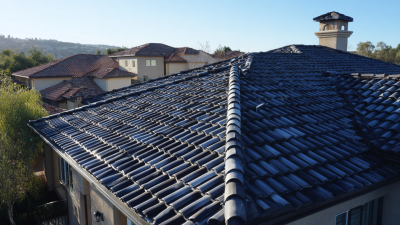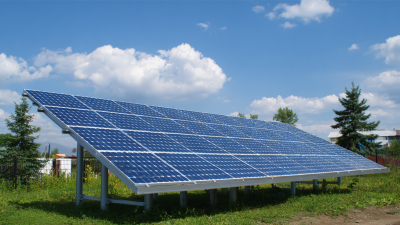The Future of Sustainable Living with Solar Cell Roof Tiles
As the world increasingly confronts the challenges of climate change and finite natural resources, innovative solutions for sustainable living have become more critical than ever. Among these solutions, solar cell roof tiles are emerging as a game-changer in the renewable energy landscape. According to the International Renewable Energy Agency (IRENA), the capacity of solar energy has grown significantly, with global installations surpassing 800 GW in 2021 alone, underpinning the escalating demand for sustainable energy sources.

Solar cell roof tiles not only provide aesthetic appeal but also integrate seamlessly into residential architecture, allowing homeowners to generate clean energy while maintaining the integrity of their home design. A study by the U.S. National Renewable Energy Laboratory (NREL) indicates that incorporating solar technologies into building materials can increase the energy efficiency of homes by as much as 40%. With advancements in technology and the decreasing cost of production, solar cell roof tiles are poised to play a pivotal role in the transition toward a more sustainable future, offering dual benefits of energy generation and cost savings.
This compelling shift towards solar infrastructure reflects a broader societal trend, where consumers are more conscious of their environmental impact and are actively seeking sustainable living solutions. As the market for solar cell roof tiles continues to expand, it is essential to explore their potential to revolutionize residential energy production and contribute significantly to a greener planet.
Benefits of Integrating Solar Cell Roof Tiles in Modern Homes
The integration of solar cell roof tiles in modern homes is not just a trend; it's a significant step towards sustainable living. According to a report by the International Renewable Energy Agency (IRENA), solar power consumption is projected to reach over 4,500 terawatt-hours (TWh) globally by 2050, marking a pivotal shift in energy production. These roof tiles seamlessly blend aesthetics with functionality, allowing homeowners to harness solar energy without compromising on style. Benefits include reduced energy bills, increased property value, and a significant decrease in carbon footprint, as homes with solar tiles produce up to 100% of their energy needs.
When considering solar cell roof tiles, there are a few tips to keep in mind. First, conduct a proper energy assessment to determine your home's energy needs and how many tiles will be necessary. Secondly, check for local incentives or rebates that can alleviate the initial installation costs, as many governments encourage renewable energy adoption. Lastly, invest in high-quality tiles from reputable manufacturers, as this ensures longevity and maximizes energy efficiency, contributing to both sustainability and economic savings in the long run.
The Future of Sustainable Living with Solar Cell Roof Tiles
| Dimension | Data |
|---|---|
| Average Cost per Square Foot | $15 - $25 |
| Energy Savings per Year | $500 - $1,200 |
| Environmental Impact (CO2 Reduction) | Up to 2 tons/year |
| Expected Lifespan | 25 - 30 years |
| Installation Time | 3 - 7 days |
| Increase in Property Value | 10% - 20% |
Key Features to Look for When Choosing Solar Cell Roof Tiles
When selecting solar cell roof tiles, there are several key features that homeowners should prioritize to ensure a sustainable energy solution. First and foremost, durability is crucial. The roofing market is increasingly emphasizing materials that can withstand harsh weather conditions while maintaining their functionality over time. High-performance coatings on metal roofs, for instance, can complement the longevity of solar panels, providing a reliable option for energy generation without frequent replacements.
Another important aspect to consider is the efficiency of the solar cells themselves. As technology advances, the efficiency ratings of solar cell roof tiles continue to improve, allowing homeowners to harness more energy from the same surface area. Potential buyers should also evaluate warranty offerings and the manufacturer’s reputation, as these factors can indicate the longevity and reliability of the product.
Additionally, ease of installation and maintenance should not be overlooked. A seamless integration of solar tiles into the roof structure can enhance both aesthetic appeal and functionality. Homeowners should ensure that their selected tiles are compatible with existing roofing systems, which can streamline the installation process and reduce potential future costs associated with upkeep. Carefully assessing these features will ultimately contribute to a more sustainable living environment powered by renewable energy sources.
Comparative Costs: Solar Cell Roof Tiles vs. Traditional Roofing Options
When considering roofing options for sustainable living, the comparative costs between solar cell roof tiles and traditional roofing solutions play a crucial role. Solar cell roof tiles are typically more expensive upfront than conventional materials such as asphalt shingles or metal roofs. The initial investment for solar tiles includes not only the cost of the tiles themselves but also the installation, which often requires specialized labor. While prices can vary by location and supplier, homeowners should expect to pay a premium for the integration of solar technology.
However, the long-term financial benefits of solar cell roof tiles can offset these initial costs. Solar tiles can generate electricity, leading to significant savings on utility bills. Additionally, many regions offer tax incentives and rebates to homeowners who choose solar, further enhancing the financial appeal. Over time, the return on investment with solar tiles can surpass that of traditional roofing options, especially in areas with high electricity rates or abundant sunlight. As technology advances and production costs decrease, solar roof tiles are becoming an increasingly viable option for environmentally conscious homeowners seeking to balance upfront costs with long-term sustainability benefits.
Maintenance Tips for Enhancing the Lifespan of Solar Roof Systems
Maintaining solar roof systems is crucial for maximizing their efficiency and lifespan. According to the
National Renewable Energy Laboratory (NREL), properly maintained solar panels can last over
25 years, providing significant energy savings throughout their lifespan. Regular inspections are essential, as they help identify any
issues such as dirt buildup, shading, or damage caused by extreme weather conditions. Cleaning the panels at least twice a year can improve
their performance by up to 20%, making maintenance not just a necessity but a smart investment.
Furthermore, it is important to monitor the inverter, which is responsible for converting solar energy into usable electricity.
NREL reports that keeping track of inverter performance can prevent inefficiencies that may decrease energy output. Additionally, ensuring the roofing material is
compatible with solar tiles can enhance the overall durability of the system. Investing in quality installation and working with
certified professionals can further protect the investment, potentially leading to maintenance costs being controlled effectively over the years, as well as ensuring
optimal functioning of the roofing system.
Future Trends in Solar Technology and Sustainable Living Solutions
The evolution of consumer preferences in home renovations increasingly reflects a desire to integrate aesthetics with functionality, particularly in the realm of sustainable living. As homeowners seek out solutions that not only enhance the beauty of their spaces but also contribute to environmental sustainability, innovations like solar cell roof tiles are gaining traction. These tiles not only ensure energy efficiency but also offer a sleek, modern appearance that appeals to discerning consumers. This shift towards multifunctional solutions is fueling market growth, as more people recognize the value of sustainable living that does not compromise on style.
Additionally, the rise of smart cities exemplifies the synergy between technology and sustainability. In this context, advancements in information technology and artificial intelligence are being harnessed to improve urban infrastructure and governmental operations, making cities more livable and environmentally friendly. As initiatives like the Sheikh Zayed Sustainability Prize attract global attention, with thousands of entries showcasing innovative solutions that benefit millions, the focus on sustainable living continues to expand. This momentum underscores the importance of creating solutions that resonate with consumers' aspirations for both style and environmental responsibility.
Related Posts
-

Understanding Issues with pv tiles in Modern Construction
-

How to Maximize Energy Efficiency with Solar Roof Slates for Sustainable Living
-

Navigating Import and Export Certifications for the Best PV Tiles in the Global Market
-

Top Strategies for Maximizing Efficiency with Best Solar Panel Roof Tiles
-

How to Secure Solar Panel Grants for Your Home Energy Needs
-

How to Maximize Efficiency with Solar Thermal Panels in Your Home